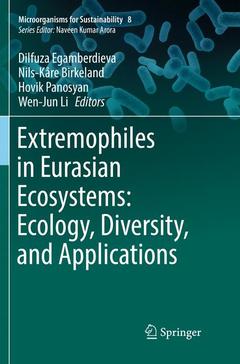Extremophiles in Eurasian Ecosystems: Ecology, Diversity, and Applications, 1st ed. 2018 Microorganisms for Sustainability Series, Vol. 8
Coordonnateurs : Egamberdieva Dilfuza, Birkeland Nils-Kåre, Panosyan Hovik, Li Wen-Jun

This book explores various aspects of thermophilic and halophilic microbes from Eurasian ecosystems, which have proved to offer a unique reservoir of genetic diversity and biological source of extremophiles. It also covers the biotechnological uses of extremophiles, and their potential use in agricultural and industrial applications. The topics addressed include but are not limited to: diversity and microbial ecology, microbe-environment interactions, adaptation and evolution, element cycling and biotechnological applications of thermophiles and halophiles in Eurasian ecosystems.
In order to review the progress made in biology and biotechnological applications of thermophiles and halophiles, the book combines review papers and results of original research from various specialists and authorities in the field. It includes several chapters describing the microbial diversity and ecology of geothermal springs distributed among the territory of various Eurasian countries, such as Armenia, Bulgaria, China, Georgia, India, Italy, Pakistan and Turkey. A dedicated chapter discusses selected aspects of thermophilic chemolithotrophic bacteria isolated from mining sites (sulfide ores); detailed descriptions of various thermophile microbes isolated from high-temperature environments and their biotechnological potential are also provided. Subsequent chapters describe the diversity and ecology of halophilic microbes harbored in saline and hypersaline lakes in Iran, Turkey and China; soil and plant microbiomes in saline arid lands of Uzbekistan; microbial diversity in Asian deserts; and the potential applications of thermophilic and halophilic microbes as exopolysaccharide (EPS) producers, focusing on the chemistry and applications of the EPS they produce.
We hope that this book will prove valuable as an up-to-date overview of the current state of research on Eurasian extremophiles in general and thermophiles and halophiles in particular. Many questions remain unanswered, and we hope that it will stimulate further studies in this intriguing and promising field.
1. Insights into the Thermophile Diversity in Hot Springs of Pakistan.- 2. Hot Springs of India: Occurrence and Microbial Diversity.- 3. Thermophiles in Terrestrial Hot Springs of Yunnan and Tibet, China.- 4. Microbial Diversity of Terrestrial Geothermal Springs in Lesser Caucasus.- 5. Geobacillus and Anoxybacillus Distributed in the Terrestrial Geothermal Springs Worldwide: Diversity and Biotechnological applications.- 6. Thermophiles and Their Exploration for Thermostable Enzyme Production.- 7. Thermophilic Chemolithotrophic Bacteria in Mining Sites.- 8. Thermophilic and Halophilic Microorganisms Isolated from Extreme Environments of Turkey, with Potential Biotechnological Applications.- 9. Hypersaline Environments of Iran; Prokaryotic Biodiversity and Their Potentials in Microbial Biotechnology.- 10. Halotolerant and Halophilic Microbes and Their Environmental Implications in Saline and Hypersaline Lakes in Qinghai Province, China.- 11. Soil Salinity and Microbes: Diversity, Ecology and Biotechnological Potential.- 12. Halophilic Actinobacteria Biological Activity and Potential Applications.- 13. Microbial diversity in Asian Deserts: Distribution, Biotechnological Importance and Environmental Impacts.- 14. Trichoderma from Extreme Environments: Physiology, Diversity, and Antagonistic Activity.- 15. Exopolysaccharide Producer Microorganisms from Extreme Areas: Chemistry and Application.- 16. Why Choose Mediocre, When Extremists Exist?.- 17. Use of Acidophilic or Acidotolerant Actinobacteria for Sustainable Agricultural Production in Acidic Soils.
Dr. Dilfuza Egamberdieva graduated with a degree in Biology from the National University of Uzbekistan in 1993. She received her PhD in Agricultural Sciences from the Humboldt University of Berlin, Germany in 2000. She pursued her postdoctoral studies at the Helsinki University of Finland (2001, 2008), University of Florence, Italy (2003), Manchester Metropolitan University, UK (2006), Leiden University of Netherlands (2007), and Leibniz Centre for Agricultural Landscape Research, Germany (2014-2017). In 2009, she established the research laboratory “Plant Microbe Interactions” at the National University of Uzbekistan. For her outstanding academic achievements she received numerous fellowship and awards including the UNESCO-L’OREAL Fellowship for Women in Science (2006), IUBMB Young Scientist Award (2006), ASM Morrison Rogosa Award (2006), UNESCO-MAB Award (2005), Alexander Von Humboldt Fellowship (2014) and in 2012 the TWAS Prize in Agricultural Sciences for her innovative contributions to the study of plant-microbe interactions in stressed environments. She has produced over 80 peer-reviewed publications in international journals and 40 chapters.
Dr. Nils-Kåre Birkeland graduated with a degree in Microbiology from the University of Bergen (Norway), and received his Dr. philos. degree in Molecular Microbiology from the University of Oslo (Norway) in 1992. He also has work experience at the NTNU (Norway), University of Tromsø (Norway), Norwegian University of Life Sciences, and from sabbaticals in USA. From 1996 he has been a Professor of Microbiology at the University of Bergen. His main research areas during the last 20 years have been anaerobic microbiology, extremophiles and microbial biotechnology. He has isolated and described a number of novel taxa of extremophiles and analysed the molecular mechanisms for high-temperature adaptations and diversity in extreme environments. He has published 97 papers in peer-reviewed journals and
Describes the diversity of thermophiles and halophiles thriving in extreme environments
Presents the microbial diversity of extreme ecosystems in the Eurasian region
Elaborates on the medical, agricultural and industrial applications of extremophiles, and their potential use in red, green and white biotechnology
Date de parution : 01-2019
Ouvrage de 464 p.
15.5x23.5 cm
Disponible chez l'éditeur (délai d'approvisionnement : 15 jours).
Prix indicatif 158,24 €
Ajouter au panierDate de parution : 08-2018
Ouvrage de 464 p.
15.5x23.5 cm
Disponible chez l'éditeur (délai d'approvisionnement : 15 jours).
Prix indicatif 158,24 €
Ajouter au panier


